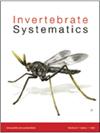形态学和DNA分析揭示了泰国Anentome wykoffi (Brandt, 1974)(腹足目:麻蝇科)的隐种多样性,并描述了2个新种
IF 1.9
2区 生物学
Q3 EVOLUTIONARY BIOLOGY
引用次数: 0
摘要
刺螺属广泛分布于东南亚。在泰国,该属包括至少6种,其中一种是可作为寄生吸虫中间宿主的Anentome wykoffi。最近的田野调查表明,A. wykoffi在泰国比人们想象的要普遍和广泛得多,但对其分类仍然知之甚少。因此,本研究通过对该物种形态和DNA序列(COI和28S rRNA)变异的研究来验证和完善该物种的分类解释。为此,在泰国对12个种群进行了抽样调查。这项调查使我们初步区分了三种假定的隐型。贝壳形状测量和几何形态分析揭示了这些形态之间的显著差异,而贝壳雕刻和radula的扫描电镜观察证实了三种形态的一致分离。最后,对COI和28S rRNA序列数据进行了系统发育和种界分析,结果表明这3种形态型代表了3个支持良好的分支,其中一个是a . cambojiensis的姐妹类群。因此,根据(1)是否有隆突肩,(2)螺旋上螺旋线的数量和(3)中央根状齿上中央尖的图案所定义的三种形态型,在形态学和系统发育物种概念下被解释为三个不同的物种,但也可能在生物学物种概念下被解释为三个不同的物种,即a . wykoffi(严格意义)。本文(重新)描述了A. longispira sp. 11和A. khelangensis sp. 11这三个隐种,并简要讨论了分离的意义。ZooBank: urn: lsid zoobank.org:酒吧:B39722E6-C915-4FA4-B03B-C15836B0DCAE本文章由计算机程序翻译,如有差异,请以英文原文为准。
Morphological and DNA analyses reveal cryptic diversity in Anentome wykoffi (Brandt, 1974) (Gastropoda: Nassariidae), with descriptions of two new species from Thailand
The assassin snail genus Anentome is widely distributed in South East Asia. In Thailand, the genus comprises at least six species, one of which is Anentome wykoffi, a species that may act as an intermediate host of parasitic trematodes. Recent fieldwork has shown that A. wykoffi is far more common and widespread in Thailand than has been assumed, yet the taxonomy remains poorly known. Therefore, this study explores morphological and DNA sequence (COI and 28S rRNA) variation in A. wykoffi to verify and finetune the taxonomic interpretation of this species. To this end, 12 populations of A. wykoffi were sampled in Thailand. This survey allowed us to preliminarily distinguish three putatively cryptic morphotypes. Shell shape measurements and geometric morphometric analyses revealed significant differences between these morphotypes, whereas SEM observations of the shell sculpture and radula confirmed the consistent separation of the three morphotypes. Finally, a combined phylogenetic and species delimitation analysis of COI and 28S rRNA sequence data showed that the three morphotypes represent three well-supported clades, one of which is sister group to A. cambojiensis. As such, the three morphotypes as defined by (1) the presence or absence of a carinated shoulder, (2) the number of spiral lines on the spira and (3) the pattern of the central cusps on the central radular tooth, are interpreted as three different species under the morphological and phylogenetic species concepts but also likely under the biological species concept, viz. A. wykoffi (sensu stricto), A. longispira sp. nov. and A. khelangensis sp. nov. The three cryptic species are (re)described and the implications of separation are briefly discussed. ZooBank: urn:lsid:zoobank.org:pub:B39722E6-C915-4FA4-B03B-C15836B0DCAE
求助全文
通过发布文献求助,成功后即可免费获取论文全文。
去求助
来源期刊

Invertebrate Systematics
生物-动物学
CiteScore
4.30
自引率
9.10%
发文量
35
审稿时长
>12 weeks
期刊介绍:
Invertebrate Systematics (formerly known as Invertebrate Taxonomy) is an international journal publishing original and significant contributions on the systematics, phylogeny and biogeography of all invertebrate taxa. Articles in the journal provide comprehensive treatments of clearly defined taxonomic groups, often emphasising their biodiversity patterns and/or biological aspects. The journal also includes contributions on the systematics of selected species that are of particular conservation, economic, medical or veterinary importance.
Invertebrate Systematics is a vital resource globally for scientists, students, conservation biologists, environmental consultants and government policy advisors who are interested in terrestrial, freshwater and marine systems.
Invertebrate Systematics is published with the endorsement of the Commonwealth Scientific and Industrial Research Organisation (CSIRO) and the Australian Academy of Science.
 求助内容:
求助内容: 应助结果提醒方式:
应助结果提醒方式:


